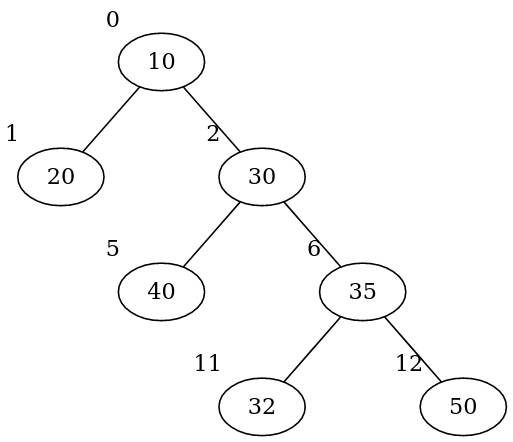Heaps
Continuing with the theme of alternate representations we just started heaps. Specifically binary heaps. binary min and max heaps.
Heaps are one of my favorite topics in CS2. If you're not familiar with them, a binary min heap is a complete binary tree that enforces the heap property. By being complete we mean that every level except possibly the last one is full - that is 2 children. The last level is as filled left to right.
The heap property for a min heap is that the key value stored in any node is less than the values in it's children. Heaps are frequently used as priority queues. There are plenty of great web sites and videos that talk all about heaps - creating them, standard operations, run time etc.
One of the things I love about them though is that they tie together arrays and trees. Up until now, we've been using pointers to represent trees. Our binary trees are represented by a class with a pointer to a root node. Each node has pointers to left and right children. Technically you could represent a heap in this way but with a heap you have to be able to not only navigate easily from parent to child but also from child to parent. This would make things a bit unwieldy with additional parent pointers.
Instead consider the following tree:

I've numbered each of the nodes with the root - node 0 holding a key value of 10. We can easily store this tree in an array:#heaps.org#

We have an easy relationship between parent and child. Given any node n,
its children are located at 2n+1 and 2n+2. Likewise we can use
integer division (n-1)/2 to find a node's parent. Easy peasy. This
is both easy and efficient and of course we can also go from an array
to a tree and in fact, the heapsort algorithm takes an arrray and
rearranges the elements into a heap and then uses heap operations to
sort the array all in place and in O(nlgn) time.
Here we have another cool representation. We can of course represent a tree by explicitly creating classes for nodes with all the required pointers but here we are implicitly creating a tree by using a mapping to relate nodes.
We could of course do this for any binary tree:


NOTE: Nodes 11 and 12 in the tree above should be 13 and 14. I messed up the graphviz dot source for the diagram and am too lazy to correct. Likewise there should be two extre cells in the array and the 32 and 50 should be in cells 13 and 14 respectively.
This is where the completeness comes in. The fact that a heap is complete and the last level is filled in left to right means that there aren't any unused cells in the array. If we just had any old binary tree like the one above, we're going to waste space. It could still at times be a useful representation.
I like talking to my students about these types of data structures and representations. Without considering cases like this you can get programmers who adhere to the saying that "If your only tool is a hammer then every problem looks like a nail."